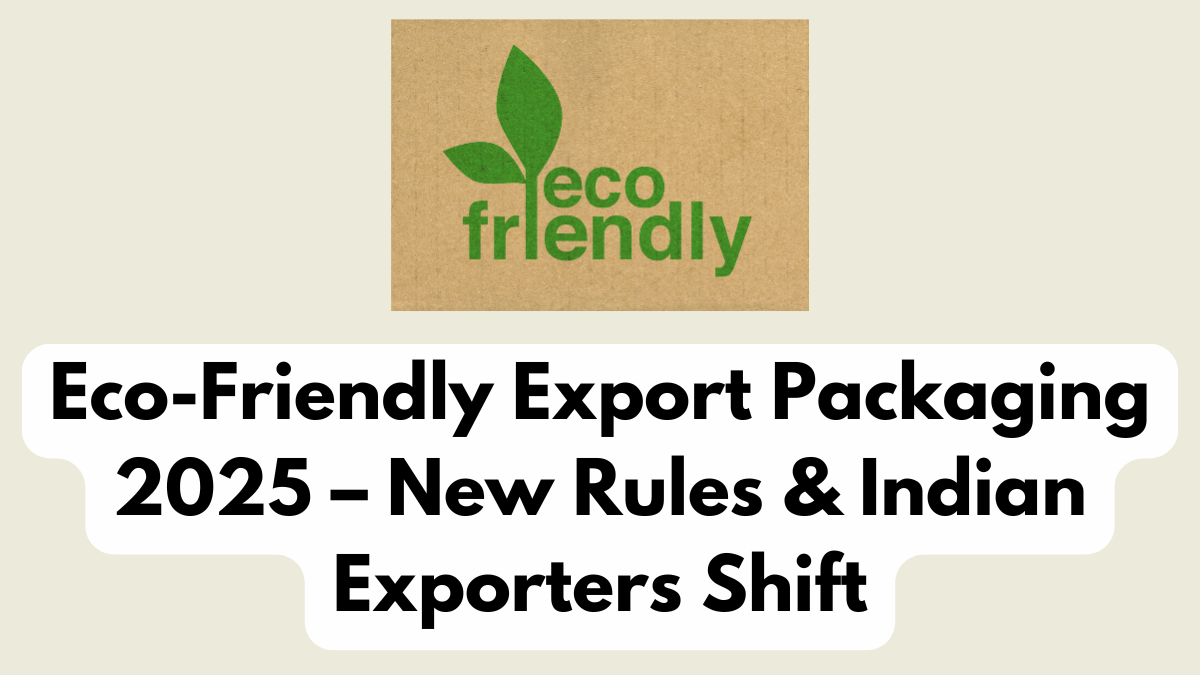In 2025, the world of international trade is undergoing a green revolution, and at the center of this transformation is the Sustainable Packaging Trend. With countries tightening their export compliance laws around plastic and non-biodegradable materials, Indian exporters are now being pushed—and pulled—toward eco-friendly, recyclable, and biodegradable packaging solutions.
Governments across Europe, North America, and parts of Asia are enforcing strict rules on product packaging. This means that Indian exporters who want to remain competitive in global markets must now rethink how they wrap, store, and ship their goods. Fortunately, the packaging India ecosystem is responding quickly with innovative alternatives that meet both environmental and legal standards.
This trend is not just a compliance necessity but also a strategic shift that aligns with global consumer demand for sustainability and greener supply chains. Let’s explore what’s changing, who’s leading, and how this green export movement is redefining India’s packaging industry.

What’s Driving the Sustainable Packaging Trend?
The shift to sustainable packaging isn’t optional anymore. From food products and garments to machinery and handicrafts, every exported item must now adhere to stricter international packaging norms. The Sustainable Packaging Trend is being driven by:
-
Mandatory export compliance laws in the EU, US, and Australia
-
Consumer demand for ethical and environmentally conscious brands
-
The rise in plastic bans and landfill taxes abroad
-
Carbon footprint disclosures required on exported goods
-
Corporate sustainability mandates from global buyers
Because of these pressures, packaging India businesses are seeing massive growth in recyclable paper, starch-based plastics, cornstarch bubble wrap, and other biodegradable options.
India’s Response to Export Packaging Challenges
India’s response to this packaging revolution has been both innovative and rapid. Exporters in sectors like textiles, spices, engineering goods, and handicrafts have already made key changes to adopt the Sustainable Packaging Trend.
Here’s a look at some of the most widely adopted eco-friendly materials by Indian exporters:
| Eco-Friendly Material | Common Uses | Export Sectors Using It |
|---|---|---|
| Corrugated Paper Boxes | Garments, Electronics, Handicrafts | Textile, Engineering, Retail |
| Starch-based Plastics | Fragile items, bubble wrap alternatives | Electronics, Ceramics |
| Jute and Cotton Bags | Loose items, premium packaging | Apparel, Gifts, Agriculture |
| Molded Pulp Trays | Custom-shaped protective packaging | Pharma, Tools, Cosmetics |
| Recycled Cardboard Sleeves | Outer protective layers for shipping | FMCG, Food Items, Stationery |
Exporters across packaging India clusters such as Sivakasi, Surat, Noida, and Ludhiana are working closely with sustainable packaging startups to scale production. The goal is not just to reduce environmental damage but to meet all export compliance documentation and labelling regulations.
Compliance Guidelines for 2025: What Exporters Must Know
With 2025 underway, Indian exporters must stay updated with new packaging-related mandates across major markets. The penalties for non-compliance are high—including delayed shipments, customs rejection, or heavy fines.
Key global export compliance rules now include:
-
European Union: Requires packaging to be 100% recyclable or biodegradable with CE markings
-
USA: Plastic packaging must meet ASTM D6400 compostability standard
-
Australia: Extended Producer Responsibility (EPR) rules apply on packaging waste
-
Canada: Exporters must provide carbon footprint certification of packaging
-
UAE & Gulf: Recyclable materials must carry local certification tags
These developments are accelerating the green export momentum in India, as more companies now assign full-time sustainability officers to manage packaging logistics.
Benefits of Going Green for Exporters
Switching to sustainable packaging isn’t just about meeting legal requirements. It’s also a long-term business strategy. Companies adopting the Sustainable Packaging Trend often report better relationships with buyers, improved brand value, and even lower costs over time.
Advantages of sustainable packaging for Indian exporters:
-
Fewer shipment rejections due to export compliance
-
Enhanced credibility in European and North American markets
-
Possibility of “green label” certifications on products
-
Long-term cost savings via bulk biodegradable procurement
-
Aligns with the global green export agenda and ESG reporting
Indian companies that embrace this early will likely see greater demand and premium pricing from foreign buyers who prioritize ethical sourcing.
Conclusion
The Sustainable Packaging Trend is not just a passing phase—it’s a future-defining movement. In 2025, being an exporter means being environmentally responsible, especially when it comes to packaging. As green export policies tighten across global markets, India’s exporters must be ready to respond with innovation, speed, and full export compliance.
Thanks to advances in packaging India, businesses now have access to cost-effective, eco-conscious packaging solutions that meet all necessary regulations. The shift may require upfront investment, but the long-term gains in brand value, customer trust, and market access make it an essential step for every serious exporter in 2025 and beyond.
FAQs
What is driving the Sustainable Packaging Trend in 2025?
Stricter export compliance rules, consumer demand, and global environmental policies are pushing Indian exporters to adopt eco-friendly packaging.
Which materials are considered sustainable for packaging?
Corrugated paper, jute bags, molded pulp trays, and starch-based plastics are widely used in packaging India sectors.
How are Indian exporters benefiting from green packaging?
Exporters adopting the green export approach enjoy smoother international clearance, better buyer relationships, and long-term cost savings.
Are there penalties for non-compliance with global packaging rules?
Yes, failing to meet export compliance standards can lead to shipment delays, fines, or rejections at international borders.
What role do packaging suppliers in India play in this shift?
Packaging India companies are crucial in developing scalable, eco-friendly solutions that help exporters meet 2025 requirements.
Click here to learn more